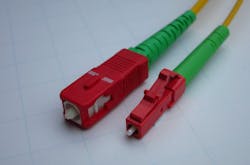Arrayed Fiber Optics Non-Contact Optical Fiber Connector
March 17, 2015
The NC optical connector provides a very reliable, low-loss optical connection. This connection should reduce end-to-end optical loss and increase optical reliability, which would reduce carrier operational expenses. Judge's Comment.
The Non-contact (NC) Optical Fiber Connector uses the same parts as an existing physical contact connector, but eliminates both the physical contact between fiber surfaces and the need for a beam-forming lens. This design results in lower insertion loss, better return loss, guaranteed random mating, and immunity from dust and dirt, Arrayed Fiberoptics says.
NC Connectors are compatible with existing physical contact connectors, which means they can be used to test transceivers with built-in connectors. They have a virtually infinite mating life, the company explains, with greater than 10,000 matings possible. They can withstand a high-vibration environment and are able to replace expanded beam connectors.
Click here to return to the 2015 Lightwave Innovation Awards page
Sponsored Recommendations
Sponsored Recommendations
April 9, 2025
April 10, 2025
March 10, 2025

